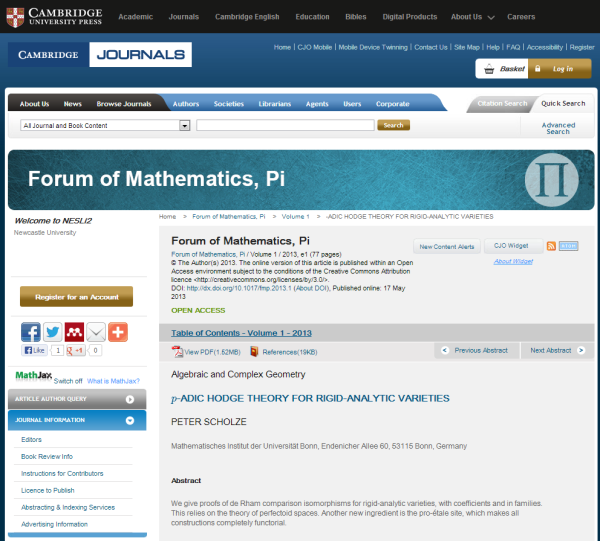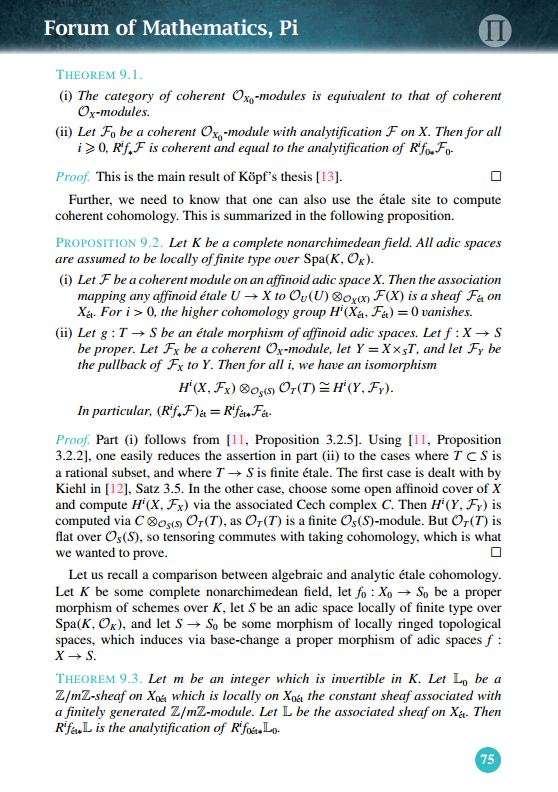I had hoped that The Future of Scholarly Mathematical Intercourse would arrive chaperoned by The Future of Publishing.
The first papers in Cambridge University Press’s new journals, Forum of Mathematics Pi and Forum of Mathematics Sigma, have been published — $p$-adic Hodge theory for rigid-analytic varieties by Peter Scholze in FoM Pi, and Generic mixing theory via vanishing Hodge models by Minhea Popa and Christian Schnell in FoM Sigma. But since the journals are more interesting for the medium they’re delivered by than their message, I’d like to take a look at the experience I had when accessing them.
As a reminder, here’s CUP’s blurb about the journals:
Forum of Mathematics, Pi and Forum of Mathematics, Sigma are an exciting new development in journal publishing. Together they offer fully open access publication combined with peer-review standards set by an international editorial board of the highest calibre, and all backed by Cambridge University Press and our commitment to quality. Strong research papers from all parts of pure mathematics and related areas will be welcomed. All published papers will be free online to readers in perpetuity. A publication charge for authors will be set at a rate justified by real publishing costs, and for the first three years Cambridge University Press will waive the publication charges.
Both journals are hosted on the same system as CUP’s other journals. It’s a very conventional system for print publishers – navigation is very hard, links to social networks and citation management systems proliferate across the page, and in general it looks like a design meeting broke up for lunch in the early 2000s. So they decided against investing in a whizzy new system to go with their whizzy new business model. That’s a bit of a disappointment.
The journals are organised into volumes and issues. Not sure why – as far as I’m aware they’re not going to print them, and they seem to be releasing papers one at a time. The paper abstract page tells me that the references to the paper in Pi are 19KB. Maybe that’s the size of the BibTeX file the authors provided, but I’m not sure – clicking on the link leads to a very heavy page and I can’t find a citations file to download.
Papers are available only as PDFs. But don’t worry, they’re definitely not meant for print – every page has enough colours on it, particularly in that enormous banner image, to make you think twice before sending it to a printer. The typeface is bizarrely large, and page margins very small. If you did end up printing out a paper, there isn’t much space for annotations. Finally, as a protanope, I find the colour used for theorem and proof headers very hard to see on the page.
For contrast, here’s a page from the preprint of the same paper on the arXiv: The CUP designers have clearly decided to make their papers look distinctive. But there’s no justification I can see, apart from just that, for the choices they made – pages are harder to read, harder to print, and it all makes the maths harder to understand.
The CUP designers have clearly decided to make their papers look distinctive. But there’s no justification I can see, apart from just that, for the choices they made – pages are harder to read, harder to print, and it all makes the maths harder to understand.
The new journals are about the business model – gold OA where the author pays, not the reader – and not the delivery mechanism, but CUP is siginificantly behind the times. Say what you will about Elsevier (I’ll go first: they’re a tumour on the body of science) but they have invested heavily in adapting to the web, and say what you want about their publishing platform, ScienceDirect (I’ll go first again: it’s actively user-hostile and I wouldn’t be sad if those responsible were forced to use every page on the web through that ridiculous scroll-breaking frameset), but they publish papers in HTML, even maths ones.
Yes, mathematics often has enormously complicated typesetting requirements that make it more difficult to adapt for the web than other disciplines, but that’s why so many of CUP’s competitors are spending money on making MathJax better.
So I’m taking this opportunity, possibly unfairly, to hector CUP for not doing something about the way they deliver research to readers at the same time as they try to make the economics of disseminating research more reasonable.
Modern scholarly publishing can be done really well — and has, by PLOS ONE. Volumes and issues don’t make sense, so they don’t use them. Look at this paper I picked (almost) at random. Everything’s on one page. It’s easy to find the things you’re likely to be looking for: abstract, references in a selection of formats, a PDF version, and THE PAPER ITSELF IS ON THE ONLY PAGE YOU EVER GET LINKED TO. Finally, mercifully, social sharing buttons are corralled into a hover menu under a small button on the right-hand side.
Is it right to expect modern access mechanisms to go hand-in-hand with modern publishing systems? Have I been spoiled by PLoS ONE’s mastery of both? Given that both papers are also available on the arXiv (Scholze; Popa & Schnell) for free, what’s the point in Forum of Mathematics if the presentation isn’t better? If the only service they’re providing is peer review, they might as well be an arXiv overlay journal.
Now that distribution is effectively free, taking research and presenting it better to aid understanding is publishers’ only real job these days. I think CUP have failed at it.
Update 20/06/2013: Gowers has posted a comment on a similarly unimpressed blog post, hinting that the design is being looked at:
The main thing to say about this is that the current design is going to be changed…
Links
$p$-adic Hodge theory for rigid-analytic varieties by Peter Scholze in FoM Pi
Generic mixing theory via vanishing Hodge models by Minhea Popa and Christian Schnell in FoM Sigma
The Good, the Bad and Gowers – discussing Timothy Gowers’s posts justifying his attachment to the Forum of Mathematics and the arXiv overlay episciences project.
ScienceDirect – Elsevier’s online publishing platform.
Thanks to David Roberts on Google+ for pointing out that the papers had gone live.


